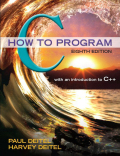
Indentify and correct the errors in each of the following. [Note: There may be more than one error in each piece of code.]

a. To identify and correct the error in the given codes.
Explanation of Solution
The error is in the first line of the code. The “if” statement shouldn’t end with a semicolon.
The correction involves the removal of the statement terminator (;) at the end of the first line of code because if there will be semicolon the puts statements won’t get executed.
The correct code will be −
if(age>=65)
puts("Age is greater than or equal to 65\n");
else
puts("Age is less than 65\n");
b. To identify and correct the error in the given codes.
Explanation of Solution
There is as such no error with the syntax or logical of the given code segment.However, it is always recommended to initialize the variables with some initial values in order to avoid problem of garbage value. Therefore, the variable “total” should be initialized with 0.
The correct code
int x=1, total =0;
while(x<=10)
{
total+=x;
++x;
}
c. To identify and correct the error in the given codes.
Explanation of Solution
There are two errors in the given code.
The first correction involves the correction of name of the keyword while from “While” to “while”.
The second correction involves the enclosing the second and third statement withincurly braces.
So, the correct code will be as follows-
while(x<=100)
{
total+=x;
++x;
}
d. To identify and correct the error in the given codes.
Explanation of Solution
The given code has the error in the while statement. The given statement is an infinite loop because y will keep on increasing (provided base value of y is positive) and will always be greater than 0.
The above problem can be solved by decrementing the y-value instead of incrementing.
The correct code will be as follows-
while(y>0)
{
printf("%d\n",y);
--y;
}
Want to see more full solutions like this?
Chapter 3 Solutions
EBK C HOW TO PROGRAM
Additional Engineering Textbook Solutions
Starting Out with Python (4th Edition)
Problem Solving with C++ (10th Edition)
Starting Out with Java: From Control Structures through Data Structures (4th Edition) (What's New in Computer Science)
SURVEY OF OPERATING SYSTEMS
Computer Science: An Overview (13th Edition) (What's New in Computer Science)
Introduction To Programming Using Visual Basic (11th Edition)
- Please solve and answer the questions correctly please. Thank you!!arrow_forwardConsidering the TM example of binary sum ( see attached)do the step-by-step of execution for the binary numbers 1101 and 11. Feel free to use the Formal Language Editor Tool to execute it; Write it down the current state of the tape (including the head position) and indicate the current state of the TM at each step.arrow_forwardI need help on inculding additonal code where I can can do the opposite code of MatLab, where the function of t that I enter becomes the result of F(t), in other words, turning the time-domain f(t) into the frequency-domain function F(s):arrow_forward
 C++ Programming: From Problem Analysis to Program...Computer ScienceISBN:9781337102087Author:D. S. MalikPublisher:Cengage Learning
C++ Programming: From Problem Analysis to Program...Computer ScienceISBN:9781337102087Author:D. S. MalikPublisher:Cengage Learning C++ for Engineers and ScientistsComputer ScienceISBN:9781133187844Author:Bronson, Gary J.Publisher:Course Technology Ptr
C++ for Engineers and ScientistsComputer ScienceISBN:9781133187844Author:Bronson, Gary J.Publisher:Course Technology Ptr Microsoft Visual C#Computer ScienceISBN:9781337102100Author:Joyce, Farrell.Publisher:Cengage Learning,
Microsoft Visual C#Computer ScienceISBN:9781337102100Author:Joyce, Farrell.Publisher:Cengage Learning, New Perspectives on HTML5, CSS3, and JavaScriptComputer ScienceISBN:9781305503922Author:Patrick M. CareyPublisher:Cengage LearningCOMPREHENSIVE MICROSOFT OFFICE 365 EXCEComputer ScienceISBN:9780357392676Author:FREUND, StevenPublisher:CENGAGE L
New Perspectives on HTML5, CSS3, and JavaScriptComputer ScienceISBN:9781305503922Author:Patrick M. CareyPublisher:Cengage LearningCOMPREHENSIVE MICROSOFT OFFICE 365 EXCEComputer ScienceISBN:9780357392676Author:FREUND, StevenPublisher:CENGAGE L Systems ArchitectureComputer ScienceISBN:9781305080195Author:Stephen D. BurdPublisher:Cengage Learning
Systems ArchitectureComputer ScienceISBN:9781305080195Author:Stephen D. BurdPublisher:Cengage Learning





